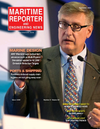
Page 22: of Maritime Reporter Magazine (September 2021)
The Marine Design Edition
Read this page in Pdf, Flash or Html5 edition of September 2021 Maritime Reporter Magazine
SHIP DESIGN MITIGATING RADIATED NOISE
LESSONS LEARNED IN
SETTING UNDERWATER
RADIATED NOISE TARGETS:
A BC FERRIES CASE STUDY
By Greg Peterson BC Ferries, Director of Engineering, Chanwoo Bae,
BC Ferries, Engineering Manager (Naval Architecture), and Derek White,
Vancouver Fraser Port Authority, ECHO Program Project Manager n a typical year, the waters surrounding British Colum- mercial vessel traf? c on at-risk whales, with a particular focus bia’s Port of Vancouver host approximately 3,000 deep on vessel-generated underwater noise.
sea commercial vessels and 19 of the 35 ferries operated In moving towards this goal, in 2015, the ECHO Program
Iby BC Ferries, one of the largest ferry operators in the began monitoring underwater noise through a cabled hydro- world. These waters are also home to a wide variety of aquatic phone system installed in the Strait of Georgia, near the inter- wildlife, including the southern resident killer whales (SRKW), national shipping lane. The hydrophone system continuously which have been listed as endangered in Canada since 2003. measured underwater noise, showing that peak noise levels
With vessel-generated acoustic disturbances identi? ed by strongly correlated with BC Ferries’ ferry schedule between
Fisheries and Oceans Canada as one of four key threats to the Tsawwassen and Nanaimo (Figure 1). This initial study com-
SRKW, the Vancouver Fraser Port Authority launched the En- pelled BC Ferries — one of the ECHO Program’s founding hancing Cetacean Habitat and Observation (ECHO) Program advisory working group members — to undertake research in 2014 to better understand and manage the impacts of com- to better understand the underwater noise contributions of its ? eet.
Measuring & Setting Targets for
Underwater Noise Levels
Between 2015 and 2017, BC Ferries contracted dedicated vessel sound trial measurements in addition to measurement opportunities via the shipping lane hydrophone system. As part of this baselining effort, an unusual trend was noted in
BC Ferries’ larger vessels: its C-Class (Queen vessels), Spirit
Class and Celebration Class vessels. In each case the radiated noise levels (RNL) level did not change, or even increased, as vessel speed was reduced. This ? nding is unlike the trend observed in most vessels, where a decrease in speed has a sig- ni? cant impact in reducing underwater radiated noise.
Following this baseline effort, BC Ferries identi? ed under- water noise reduction as an objective and set an ambitious ? eet-wide target of a 50 percent reduction in underwater noise based on typical sound levels from ferries crossing Strait of
FIGURE 1: Sound Pressure Levels
Georgia in the 2016 measurements. measured in the Strait of Georgia
In 2018, BC Ferries advanced this effort by including un- during a typical day.
22 Maritime Reporter & Engineering News • September 2021
MR #9 (18-33).indd 22 9/7/2021 9:38:45 AM

 21
21

 23
23
